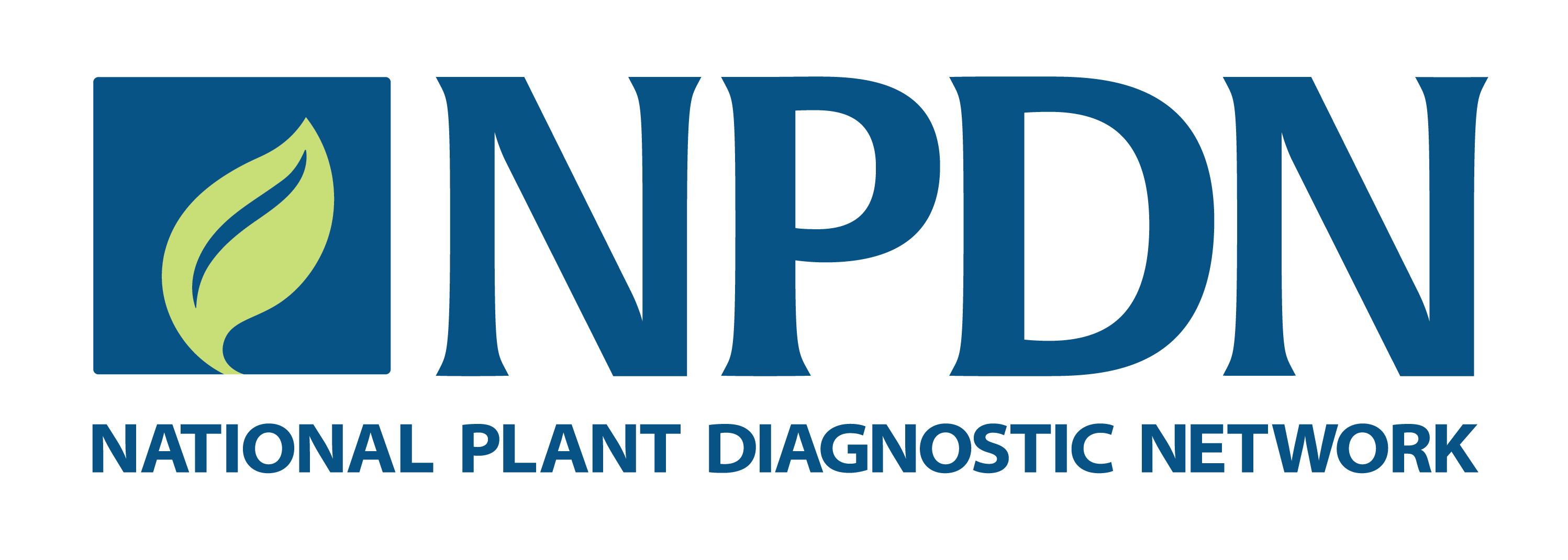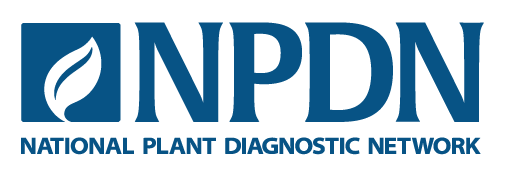The NPDN National Data Repository (NDR) houses a wide diversity of diagnostic data from all states and territories of the US. NPDN strives to ensure that the data submitted is of high quality. However, diagnostic data comes from multiple diverse sources, and diagnostic confidence can vary from one lab to another. Users must understand the source of the data in order to properly interpret it. This document explains the breath and limitations of data housed in the NDR.
Diagnostic data in the NDR
The NDR receives data for samples diagnosed with bacteria, fungi, virus, insects, mites, arachnids, nematodes, gastropods, plant identifications, herbicide resistance testing, nutrient deficiencies and toxicities, and other various abiotic disorders.
Diagnostic needs and lab capabilities vary widely among states. Thus, NPDN labs vary in the type of samples they receive and report. For instance, some labs may receive samples from private citizens, home gardeners, industries, and/or commercial growers, while others may have a strong focus on research and extension and service specific industries. Also, some labs may receive regulatory samples while others do not. Differences among labs and states will be reflected in the types and quantity of data that is submitted to the NDR. As a result of these differences, sampling effort and diagnostic information may not always be comparable among states.
Diagnostic capability also differs among NPDN labs. For example, some NPDN labs may have an entomologist on staff and submit lots of quality entomology diagnosis, while other labs may limit their entomology diagnosis to higher taxonomic levels. Also, some labs may lack expertise, facilities, or equipment to accurately diagnose or identify some organisms such as nematodes or viruses and report fewer of those diagnoses.
Most of the data in the NDR comes from NPDN diagnostic labs at land grant universities, and few regulatory or private labs. Most states have many labs that do not belong to NPDN. Thus, the data available in the NDR is not a comprehensive list of organisms present in any one state, but a list of organisms that have been diagnosed and uploaded by NPDN labs. Some organisms of concern do not get reported to the NDR as early detections, due to regulatory restrictions in specific states.
Types of diagnosis in the NDR
The NDR houses pest and disease diagnostic data that may stem from two very different types of diagnostic requests: identification analysis and surveys.
Identification analysis are requests to identify the cause of a problem or an organism submitted by diagnostic lab clients. The client submits a sample to have the cause of a particular problem or symptom determined, and/or to request management recommendations. The diagnostician evaluates the sample and uses a variety of tests and techniques to narrow down the cause of the problem, or rule out potential causes. Depending on the diagnostic capability of a lab, identification analysis reports can include suspected or undetermined diagnosis, where the diagnostician was unable to properly identify the organism or causal agent (see confirmatory information section below).
Diagnostic labs also analyze samples for surveys screenings. Survey samples are often collected for regulatory purposes or research. A client (or the lab itself) collects multiple samples to test for the presence of specific organisms. Diagnosticians screen test these samples in batches using the same method(s) for all samples (such as ELISA or qPCR). In screenings, diagnosticians are only looking at the presence/absence of the organism(s) they are screening testing for. Hence, survey data often has non-detected diagnosis where the specific organism(s) were not found (see confirmatory information section below).
The NDR does not differentiate diagnosis resulting from identification analysis or surveys. More importantly, the data in the NDR is not based on any one systematic survey, but instead is based on passive surveillance, what is submitted to a lab. Hence, NDR data is not correlated to incidence or occurrence, and can not be used to determine prevalence of a disease or organism.
Confirmatory information in the NDR
Not all diagnoses submitted to the NDR represent confirmed detections. Diagnostic data in the NDR may be Confirmed, Suspected, Not detected, or Undetermined. Confidence level varies depending on the method used, difficulty of the diagnosis, taxonomic confusion, the quality of the sample, and lab capabilities. In addition, the NDR allows identifications to contain different confidence levels for genus and species. For example, a diagnosis may be confirmed at the genus level and suspected at the species. Read here the definitions and interpretation of diagnosis confidence levels.
Users need to pay close attention to the confidence levels associated with the diagnosis in order to avoid misinterpreting the data. NDR users can also request to have only confirmed records listed.
Diagnostic methods
The accuracy and specificity of different diagnostic methods varies. For example, molecular confirmation is often more specific than visual, and some ELISA tests are more accurate than others. Diagnostic records in the NPDN NDR come from diverse labs throughout the country using different protocols and confirmation methods, as appropriate for the sample submitter’s specific situation. Additionally, diagnostic and reporting methods have evolved over the 20+ years that the NPDN NDR has been collecting data. As a consequence, the user must be aware that there might be false positives and negatives in the database. It is prudent to verify unexpected results before publishing information that would affect agricultural producers or have regulatory consequences.
Results can be verified by considering the diagnostic method and, when in doubt, contacting the lab. Users can request the the lab method of the diagnosis when viewing data. The information on lab and sample ID are also important if users need to verify the data with the lab. Users can verify a rare record by contacting the lab directly to request additional information. If this level of verification is needed, please contact it@npdn.org.
Other recommended reading to understand the NDR data:
- Introduction to the National Data Repository
- How to interpret the confidence level of the diagnosis
- Diagnostic method description as entered in the NDR
If you have questions or want to report a problem in this page please contact the NPDN National Data Committee at data@npdn.org.

